
Attacus atlas, the Atlas moth, is a large saturniid moth endemic to the forests of Asia. The species was described by Carl Linnaeus in his 1758 10th edition of Systema Naturae.

Saturniidae, members of which are commonly named the saturniids, is a family of Lepidoptera with an estimated 2,300 described species. The family contains some of the largest species of moths in the world. Notable members include the emperor moths, royal moths, and giant silk moths.

Eacles imperialis, the imperial moth, is a member of the family Saturniidae and subfamily Ceratocampinae. It is found mainly in the East of South America and North America, from the center of Argentina to south Canada. The species was first described by Dru Drury in 1773.
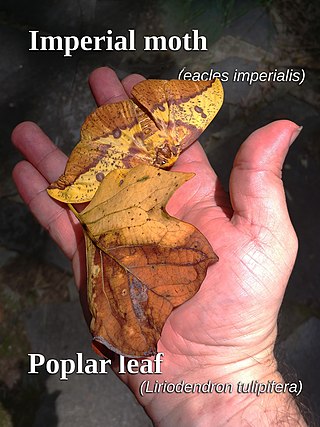
Eacles is a genus of moths in the family Saturniidae. They are native to the Americas. The genus was erected by Jacob Hübner in 1819.

The Saturniinae or saturniines are a subfamily of the family Saturniidae, also known as giant silkmoths. They are commonly known as emperor moths or wild silk moths. They are easily spotted by the eyespots on the upper surface of their wings. Some exhibit realistic eye-like markings, whilst others have adapted the eyespots to form crescent moon or angular shapes or have lost their wing scales to create transparent windows. They are medium to very large moths, with adult wingspans ranging from 7.5 to 15 cm, in some cases even more. They consist of some of the largest sized Lepidoptera, such as the luna moth, atlas moth, and many more. The Saturniinae is an important source of wild silk and human food in many different cultures.

Eupackardia is a monotypic moth genus in the family Saturniidae erected by Theodore Dru Alison Cockerell in 1912. Its only species, Eupackardia calleta, the calleta silkmoth, was described by John O. Westwood in 1853. It is found in Mexico, Guatemala, as well as in the states such as; Arizona, New Mexico, and Texas.

Eacles oslari, or Oslar's eacles, is a moth of the family Saturniidae. It is found from the Santa Rita, Patagonia, Atascosa and Huachuca mountains of southern Arizona south into Sonora, Sinaloa and Chihuahua in Mexico. Wings vary from yellow to purple brown. The species was first described by Walter Rothschild in 1907.

Rothschildia maurus is a moth of the family Saturniidae. It is found in South America, including Paraguay, Argentina and Bolivia.
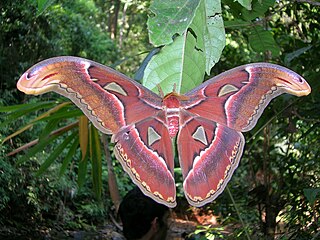
Attacus is a genus of moths in the family Saturniidae. The genus was named by Carl Linnaeus in his 1767 12th edition of Systema Naturae.
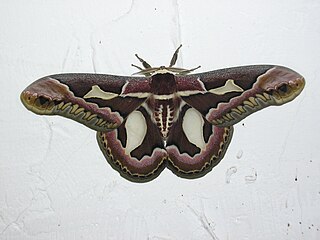
Rothschildia is a genus of moths in the family Saturniidae first described by Augustus Radcliffe Grote in 1896.

Anisota oslari, or Oslar's oakworm moth, is a moth of the family Saturniidae. It is found from south-western Colorado south through New Mexico and south-eastern Arizona to far western Texas and Mexico.
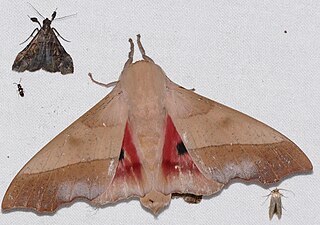
Syssphinx is a genus of moths of the family Saturniidae. The genus was erected by Jacob Hübner in 1819.

Othorene purpurascens is a species of moth of the family Saturniidae.
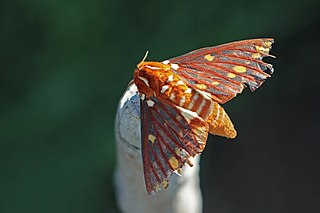
Citheronia is a genus of moths in the family Saturniidae. The genus was erected by Jacob Hübner in 1819.

Microdulia is a genus of moths in the family Saturniidae first described by Karl Jordan in 1924. It contains only one species, Microdulia mirabilis, described by Rothschild in 1895, which is found between 35° and 47°S in Chile and Neuquén in Argentina.

Rothschildia jorulla is a species of moth in the family Saturniidae first described by John O. Westwood in 1854. This species is found in Mexico and Central America. Larvae feed on plants of a large number of families.

Rothschildia orizaba, the Orizaba silkmoth, is a moth in the family Saturniidae. The species was first described by John O. Westwood in 1854. It is found in Mexico, Central and South America.

Rothschildia zacateca is a species of moth in the family Saturniidae first described by John O. Westwood in 1854. It is found in Colombia and Peru.

Caio championi is a large moth of the family Saturniidae first described by Druce in 1886. It is found from Mexico to Guatemala, south to western Ecuador and northern Venezuela.
Rothschildia forbesi, the Forbes' silkmoth, is a species of silkmoth in the family Saturniidae.



















